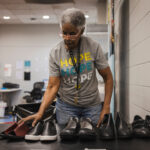Key points:
Neurodiversity is a key factor in designing learning spaces
How to use UDL-inspired technology to reengage students
How to create inclusive learning environments with UDL
For more news on learning environments, visit eSN’s Innovative Teaching hub
Every student is different–but not all learning environments are designed to meet the needs of neurodiverse learners. As schools seek to ensure all students learn to their fullest potential, a new guide explores ideas and strategies for creating inclusive learning spaces.
While there are neurodiverse students in every school in the country, many learning environments are not designed to address their unique gifts and needs. To help schools support neurodiverse learners and enrich the learning experience of all students, has published a new white paper, “
Redesigning Learning Spaces for Neurodiverse Learners, an eight-page guide from MiEN Company, authored by special needs consultant Cecilia Cruse, MS, OTR/L, delves into neurodiversity and examines new research and existing challenges for neurodiverse students.
It also explores current teaching practices and frameworks such as Universal Design for Learning (UDL), offering actionable tips to help schools support neurodiverse students and prioritize inclusive strategies and practices.
“Some brains function differently than ‘neurotypical’ brains, and some students may require different supports,” said MiEN Company’s VP of Education and Marketing, Dr. Christina Counts. “With this white paper, educators and school support staff can gain new insights into neurodiversity, reimagine their instructional practices, and create classrooms and learning spaces where all learners can thrive.”
According to the guide, leading challenges contributing to environments that don’t support neurodiversity include:
Misunderstanding of neurodiversity
Lack of professional learning about how the brain works
Rigid teaching methods
Overly restrictive classrooms
Limited access to resources and accommodations
The guide offers practical ways to promote neurodiversity (for all 12 tips, download the guide):
1. Promote understanding by creating awareness initiatives with all stakeholders: educators, staff, students, and parents. Include neurodiversity in curriculum materials at an early age.
2. Enhance professional learning by ensuring educators remain informed about the latest research and inclusive practices, including teaching strategies.
3. Implement flexible seating arrangements, sensory-friendly classrooms, and quiet zones to accommodate diverse learning needs.
4. Create personalized plans for neurodivergent students detailing specific accommodations, goals, and support strategies.
5. Establish a peer system pairing neurodivergent students with neurotypical students.
As schools seek to ensure all students are able to learn to their fullest potential, a new guide explores ideas and strategies for creating inclusive learning spaces. Featured on eSchool News, Innovative Teaching, Universal Design for Learning, help, learning, news, school, schools, student, students, support, teaching, visit eSchool News









